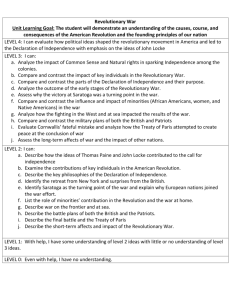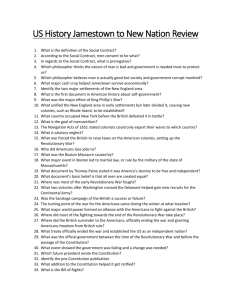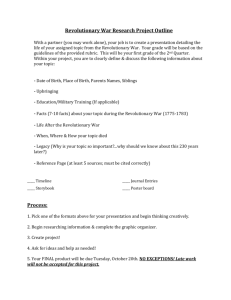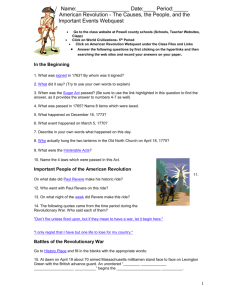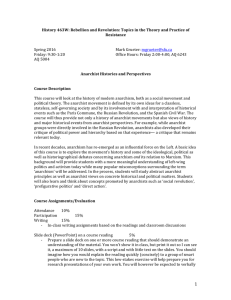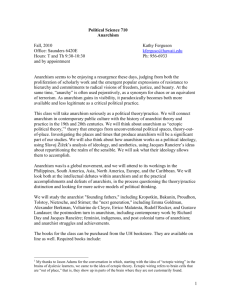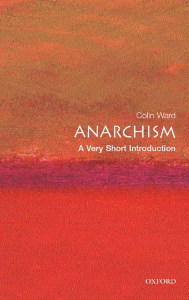Revolutionary syndicalism serves the proletariat
advertisement
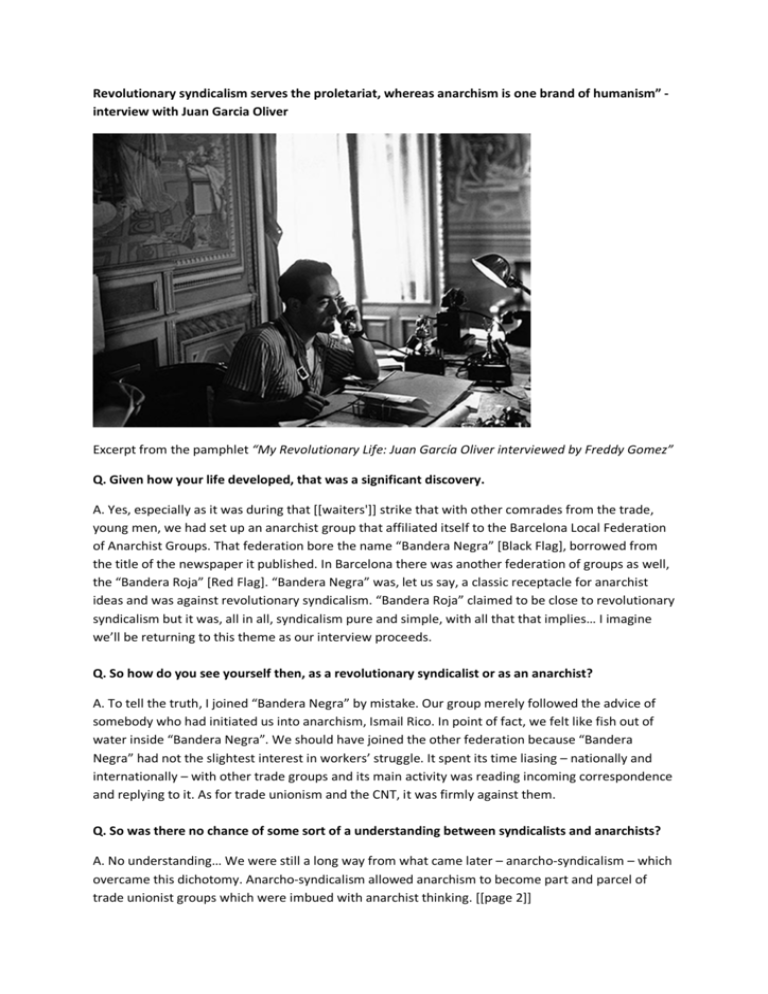
Revolutionary syndicalism serves the proletariat, whereas anarchism is one brand of humanism” interview with Juan Garcia Oliver Excerpt from the pamphlet “My Revolutionary Life: Juan García Oliver interviewed by Freddy Gomez” Q. Given how your life developed, that was a significant discovery. A. Yes, especially as it was during that [[waiters']] strike that with other comrades from the trade, young men, we had set up an anarchist group that affiliated itself to the Barcelona Local Federation of Anarchist Groups. That federation bore the name “Bandera Negra” [Black Flag], borrowed from the title of the newspaper it published. In Barcelona there was another federation of groups as well, the “Bandera Roja” [Red Flag]. “Bandera Negra” was, let us say, a classic receptacle for anarchist ideas and was against revolutionary syndicalism. “Bandera Roja” claimed to be close to revolutionary syndicalism but it was, all in all, syndicalism pure and simple, with all that that implies… I imagine we’ll be returning to this theme as our interview proceeds. Q. So how do you see yourself then, as a revolutionary syndicalist or as an anarchist? A. To tell the truth, I joined “Bandera Negra” by mistake. Our group merely followed the advice of somebody who had initiated us into anarchism, Ismail Rico. In point of fact, we felt like fish out of water inside “Bandera Negra”. We should have joined the other federation because “Bandera Negra” had not the slightest interest in workers’ struggle. It spent its time liasing – nationally and internationally – with other trade groups and its main activity was reading incoming correspondence and replying to it. As for trade unionism and the CNT, it was firmly against them. Q. So was there no chance of some sort of a understanding between syndicalists and anarchists? A. No understanding… We were still a long way from what came later – anarcho-syndicalism – which overcame this dichotomy. Anarcho-syndicalism allowed anarchism to become part and parcel of trade unionist groups which were imbued with anarchist thinking. [[page 2]] … So, a fortnight after the proclamation of the [[Spanish]] Republic, the 1 May 1931 demonstration concluded in a revolutionary rally and spilled over into an attack on the palace of the Generalitat of Catalonia. And it was on that occasion that red-and-black flags put in appearance. Q. For the fist time? A. Yes. That flag symbolized the marriage of syndicalism and anarchism. This is a point worth exploring. It was after Salvador Seguí’s death that unity was achieved between anarchists and syndicalists, spontaneously, so to speak, without negotiation of any sort. The notion of anarchosyndicalism dates from then. Previously, it had [[page 6]] never been used. With Seguí’s death the situation took such a serious turn that naturally the anarchists’ and syndicalists’ activities blended into one, leading to the demise of the “Bandera roja” and “Bandera negra” federations. The amalgamation was total and there was no prior agreement by any sort of a congress. Everybody realized that we needed to start afresh and devise new forms of struggle, which we did. The reformists were no longer a hindrance to the revolutionary struggle. True, for eight years the activities proper of the organisation were stymied by the dictatorship, experiencing a resurgence come the Republic. The black and red flag was the symbol of this new era of anarchist-syndicalist fusion. I had argued this notion of anarcho-syndicalism to members of the CNT and to Spanish émigrés living in France during the dictatorship. As I saw it, on their own, the anarchists could not make the revolution. As for certain syndicalists, their views distanced them from it. The only possible option was to amalgamate them both and embrace this idea of anarcho-syndicalism. Q. In the history of the Spanish libertarian movement, you will surely go down as one who introduced a measure of revisionism where anarchism is concerned. On two core issues – the issue of the seizure of power and the issue of the revolutionary army – you were even openly flying in the face of the classical approaches of traditional anarchism. What would you say to that? A. Look… If we espouse a strictly anarchist viewpoint, my stance vis a vis taking power or forming a revolutionary army would be nonsensical. If we take a revolutionary syndicalist line, these things were logical. Some day we are going to have to work out a precise definition of the notion of “direct action” which is part and parcel of revolutionary syndicalism. True, in his day Anselmo Lorenzo equated direct action with strikes and sabotage, but that definition is too restrictive. The notion of direct action is in fact very clear: it is the only way of guaranteeing the success of the working class as a class. To that end it must be studied and put into practice and all the consequences of it faced up to. The alternative is as follows: either the working class, by means of direct action, achieves its own emancipation as a class or it will be reduced forever to some form of more or less well paid slavery. In other words, it gets used to be treated – economically and [[page 7]] politically – as some inferior class, or it organizes itself into a union and practices direct action. Besides, direct action can vary according to circumstances. For instance, back in the 1920s, I saw the syndicalists of Barcelona enforcing “red censorship”. The bourgeois press would carry a number of articles defamatory of syndicalists who were arming themselves in self-defence against the bosses’ hired killers, so the CNT decided to implement “red censorship”. It was straightforward: the printing workers affiliated with the CNT saw to it that what they judged to be defamatory was censored. That practice did not enjoy the support of the anarchist Federico Urales who was pretty much a radicalised liberal who always treated liberalism and anarchism as the same. He went so far (in a Madrid newspaper) as to denounce “red censorship” as anti-anarchist… Which brings us to the nub of the matter. In the fight they wage in pursuit of their victory as a class, the workers determine the forms of direct action for themselves. We are dealing here with the logic of class confrontation. These fighting methods are not 100% anarchist, they are 100% revolutionary syndicalist. The notion of anarcho-syndicalism is an attempt to arrive at some possible blending of the class fighting methods and anarchism, in the knowledge that revolutionary syndicalism serves the proletariat, whereas anarchism is one brand of humanism.” [[page 8]] === excerpted from the pamphlet “My Revolutionary Life: Juan García Oliver interviewed by Freddy Gomez”, translated by Paul Sharkey. (London & Berkeley: Kate Sharpley Library, 2008). Taken from radicalarchives

